Stormtrooper Infantryman, Assault Battalion, Western Front 1918
- Scale / Maßstab: 1:15 / 120mm
- Material: Resin, Model Plaster / Modell-Gips (synethetische, kunststoffveredelte Gießmasse)
- Parts / Teile: 23
- Infosheet / Infoblatt: English / German
- Code: 08ST
- Weight / Gewicht: 140 g
- Price / Preis: 39,00 EUR
Contents / Inhalt:
- Figure (8 parts) / Figur (8 Teile)
- 2nd Alternative Head / 2. Kopf
- 2 x Grenade Bags / Tragebeutel für Handgranaten
- Water Bottle M1997 / Feldflasche M1907
- Haversack M1887 / Brotbeutel M1887
- Gas Mask M1917 / Gasmaske M1917 Metallbehälter
- Army Spade M1822 / Heeresspaten M1822
- Pickaxe / Spitzhacke
- Bayonet 84/98 / Seitengewehr 84/98
- Mauser Carbine 98 AZ / Mauserkarabiner 98 AZ
- 2 x Straps / 2 Stck. Riemen
- Stick Grenade M.15 / Stielhandgranate M.15
- Steel Helmet M1916 / Stahlhelm M1916
- Steel Helmet with Sandbag Cover / Stahlhelm mit Stoffbezug
- Figure Base / Figur-Sockel
Extracts from the Infosheet with this figure:
Steel Helmet: Stahlhelm M.16. This helmet, which first entered service in 1916 during the initial stages of the battle of Verdun was designed by Professor Friedrich Schwerd and made from high quality chrome-nickel steel. Weighing between 950 and 1200g, depending on size – more heavier than the Allied helmets, but giving a better protection to the face, ears and neck. The horn venting bolts on each side enabled the fitting of an extra armoured shield – Stirnschild – over the helmet (also available in 1:15th/ 120mm scale from Jon Smith Modellbau) for sentries, MG troops, snipers or other particularly exposed / dangerous employment. This weighing around 2000g was seldom used; although a total of 50000 were supposedly produced.
Colour: issued in field- grey, which would reflect in sun light and proved unsatisfactory. Various trials were carried out, but it was not until July 1918 that an official camouflage scheme in brown and green sharp-edged irregular patens, all outlined in black was introduced. These were carried out by unit maintenance workshops (other weapons and equipment, particularly artillery pieces and MGs were also rendered in the same way). It seems that helmets were re-painted by individuals or units in a variety of colour schemes before the official order and items with red- brown, ochre (brownish- yellow), green and blue- grey, all outlined in black were common. Helmets were also covered using the light brown sandbag material, or the issued helmet-covers, seen particularly in the later war period.
The M.17 & 18 helmets followed with only slight differences to the inside padding and chin strap fasteners. The last model to see service during the war, if only in small numbers was the M.18 Ohrenausschnitt, or Helmet M.18 with ear cut-outs (also available in 1:15th/120mm scale from JSM), more commonly and stubbornly known as the Cavalry or Telegraph Helmet. The cut-outs were in fact a further design feature of the M.18 to improve the hearing ability of the wearer and avoid the hissing noise experienced by troops.
Note: The rim and underneath edge of the helmet can be thinned out, giving a more realistic appearance of the original item – for casting reasons this has to be thicker. The chin strap supplied can be formed around the figure’s head using the application of heat (either hot water or hairdryer, holding of cause with tweezers etc.). The length of strap will need shortening, using the finished head / helmet already completed. Alternately, one can use the brown card supplied, which can represent leather or material chin straps etc. Cut the card approx. 1.2mm wide and 22 mm long and flatten or rub down on a hard surface with a blunt tool (handle of a modelling knife is ideal). Bend the strip around a pencil to give a natural curve and glue into position on the figure. The colour, thickness and texture achieved from rubbing down the card gives a good reproduction of leather in this scale.
Mauser Carbine 98 AZ: Mauserkarabiner 98 AZ. (K98 was a post war designation – AZ stands for Aufplanz- und Zusammensetzvorrichtung – one could stand the carbines up in 3s linked to each other by means of the metal hook, at the end of the barrel). Many of the stormtrooper units were equipped with this Carbine 98 AZ, which was shorter than the standard rifle issued Gewehr 98, used by the infantry. They both had about the same performance within the reduced ranges of trench warfare. A further advantage over the Gewher 98 was that the bolt folded down against the stock of the carbine, therefore reducing the danger of being snagged on uniforms and equipment etc.
Grenade Bags: Tragebeutel für Handgranaten. Made out of sand bags, being tied together with a cord over the shoulders behind the neck and waist. It was a common practice and ideal for carrying grenades of all kinds and spare ammunition. Colour: light- brown.
Army Spade: Heeresspaten M1822. Carried in a canvas holder attached to the belt and shoulder strap (they used, amongst other things the leather coat fastening straps from the Tornister – rucksack). Assault troops had to at times quickly dig-in, or repair or reverse newly taken positions. A pickaxe is supplied with the figure as an alternative. Colour: shaft – natural wood. Canvas holder – brownish-yellow, reinforced leather edges to holder.

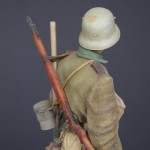
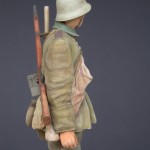
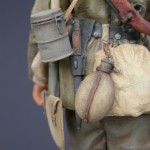
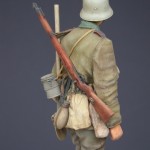
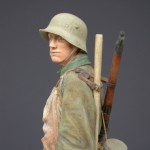
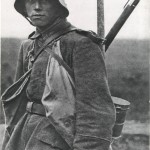
 An deutschsprachige Interessenten:
Sie können mich per eMail oder Telefon auch gerne auf deutsch kontaktieren. Ortsbesuch ist nach Absprache möglich.
An deutschsprachige Interessenten:
Sie können mich per eMail oder Telefon auch gerne auf deutsch kontaktieren. Ortsbesuch ist nach Absprache möglich.